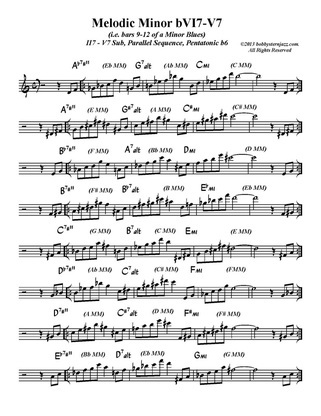
As the bVI7 could normally be given a #11, that would infer a Lydian Dominant (fourth mode of Melodic Minor), which would be an excellent scale choice.
The V7 could be given the full altered treatment, and will for the purposes of this example.
Translating that into C minor, we get:
bVI7: Ab7#11 / V7: G7alt / I: C min / C min /
If we examine the Ab7#11 a little closer, we see that this dominant chord / scale is interchangeable as a tritone substitution with the other Melodic Minor dominant chord / scale, namely D7alt and the D altered scale. Both are derived from the Eb Melodic Minor scale system, and as we all know too well (don't we?):
Any Melodic Minor chord or mode can be substituted for any other Melodic Minor chord or mode of the same Melodic Minor "key".
If you are familiar with a typical Melodic Minor ii chord, you'd know that a Dmin7b5 would normally come from the 6th mode (Locrian #2) of F Melodic Minor (D-E-F-G-Ab-Bb-C), followed by the V7, derived from the 7th mode of Ab Melodic Minor (G-Ab-Bb-Cb-Db-Eb-F).
Using the bVI (Ab7#11) as a tritone sub for a minor ii chord (Dmin7b5), adds a bluesy funkiness to the sound through an emphasis on its b7 (F#), which is the flatted 5th ("blue note") to the home key (C), as well as containing the minor third (Eb) to the home key.
To add another layer of intrigue, this exercise is based on a sequence using a pattern formed from the Pentatonic b6, which is itself derived from the 5-6-7-9-b10 scale steps of Melodic Minor.
This pattern works as follows: 7-9 (pickup) b10-5-6-9-7 of Eb Melodic Minor. It then repeats exactly up a fourth in Ab Melodic Minor and repeats once more up a Maj. 3rd in C Melodic Minor.

 RSS Feed
RSS Feed









